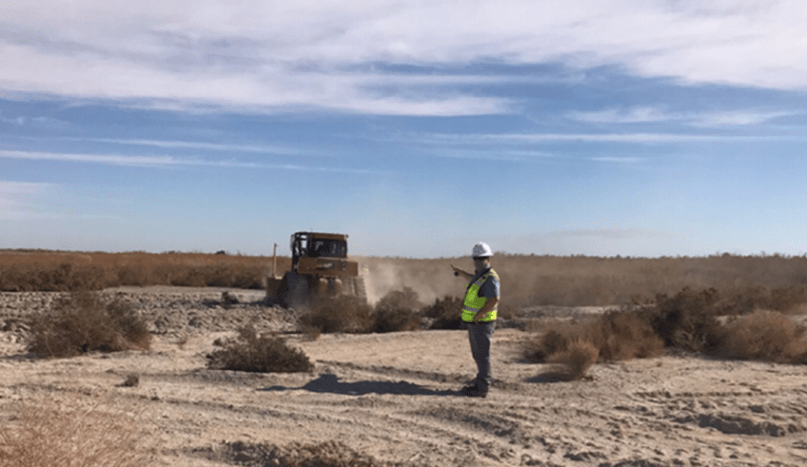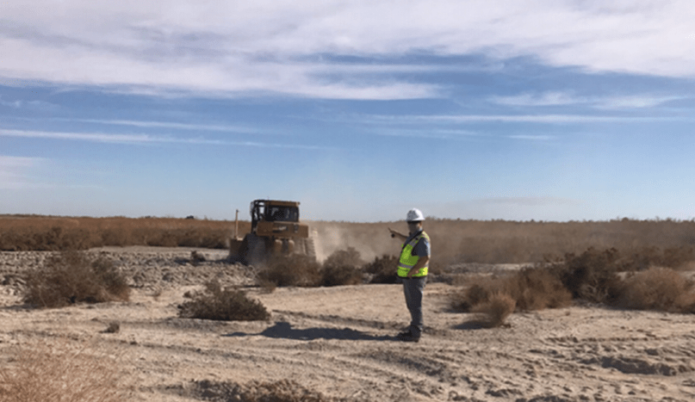
As 2021 kicks off, there is going to be a lot to discuss in blogs on this IV-San Diego Currents site—a site dedicated to sharing information on critical water issues as well as community features that showcase people, organizations and programs all making a difference in the Imperial Valley. For today’s blog, there is some positive news to report from the California Natural Resources Agency’s (CNRA) Salton Sea Management Program (SSMP). Work has begun on the state’s premier proof of concept project called Species Conservation Habitat (SCH), which is a 4,100 acre-facility that will be built in the southwest corner of the Salton Sea. The project consists of constructing a series of ponds meant to maintain fish life and support bird life. The project will also serve as an important component for protecting public health from emissive dust.
The project is a credit to the efforts by the Imperial Irrigation District (IID) and the state to resolve earlier easement issues so that the $206 million project could move forward. According to a press release from the state, the design-build contractor on the project, Kiewit Infrastructure West Co., began work in January. Construction will continue through the end of 2023.
The press release included a statement from CNRA Secretary Wade Crowfoot who states, “Beginning actual construction on this large project represents important progress. It is only possible thanks to strong coordination with our local, state and federal partners, including Imperial Irrigation District, Imperial County, the Imperial County Air Pollution Control District, the Colorado River Regional Water Quality Control Board, the U.S. Army Corps of Engineers and the U.S. Fish and Wildlife Service. Obviously, much more work lies ahead. We need to continue to deliver projects on the ground that improve conditions at the Salton Sea for residents as well as for wildlife.”
Moving forward with this project does represent a step forward, and a reason to be hopeful for more positive developments as the SSMP builds momentum. But, as Secretary Crowfoot stated, there is more work to be done and this is just a beginning point for the state’s restoration program. Certainly as large as a 4,100-acre project is, it still represents only one piece of what ultimately will have to be a large and sustained restoration effort. There is reason to be cautiously optimistic that the state’s SSMP Phase One Ten-year Plan will be fully funded and will move forward, and that the state will be moving forward with a long-range plan as well.
At the same time the state is moving forward with the SCH project—and implementing other dust control measures—the Quantification Settlement Agreement Joint Powers Authority (QSA JPA) made up of the IID, San Diego County Water Authority, Coachella Valley Water District and state is moving forward with an air quality mitigation program (separate from, but complimentary to, the state’s SSMP) at the sea that to date has provided more than 2,000 acres of ground roughening projects to prevent dust emissions at the southwest corner of the sea. Additionally, planning for another 7,000 acres of air quality projects is underway. The QSA JPA has also incorporated some vegetation into its projects, which will be expanded, as well as conducted other pilot projects, including to reclaim playa for agriculture. This mitigation program by the QSA JPA is ongoing.
Working together, the Salton Sea can be addressed and something positive can be accomplished. We see it through the efforts of the Salton Sea Authority working together with the state, which led to a Memorandum of Understanding to expand their joint efforts; we see through Imperial County working with the state on a project to benefit the residents of Desert Shores; and we see it through the ongoing effort of federal authorities to engage on the sea, through the latest developments with the SSMP, and through the QSA JPA.
Without question, more needs to be done, and more will be done. That’s not to diminish just how challenging it is to address the sea—or to suggest there aren’t differences of opinion among stakeholders on how to restore the sea—but what seems clear is that moving into 2021, no stakeholder involved with the Salton Sea is turning away from this incredibly important body of water that is a key part of the Colorado River system. Stay tuned to this blog for more updates as SCH and other projects move forward.
